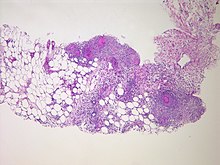| Peritonitis | |
|---|---|
| Other names | Surgical abdomen, acute abdomen[1] |
 | |
| Peritonitis from tuberculosis | |
| Pronunciation | |
| Specialty | Emergency medicine, general surgery |
| Symptoms | Severe pain, swelling of the abdomen, fever[2][3] |
| Complications | Sepsis (sepsis is likely if not quickly treated), shock, acute respiratory distress syndrome[4][5] |
| Usual onset | Sudden[1] |
| Types | Primary, secondary, tertiary, generalized, localized[1] |
| Causes | Perforation of the intestinal tract, pancreatitis, pelvic inflammatory disease, cirrhosis, ruptured appendix[3] |
| Risk factors | Ascites, peritoneal dialysis[4] |
| Diagnostic method | Examination, blood tests, medical imaging[6] |
| Treatment | Antibiotics, intravenous fluids, pain medication, surgery[3][4] |
| Frequency | Relatively common[1] |
Peritonitis is inflammation of the localized or generalized peritoneum, the lining of the inner wall of the abdomen and cover of the abdominal organs.[2] Symptoms may include severe pain, swelling of the abdomen, fever, or weight loss.[2][3] One part or the entire abdomen may be tender.[1] Complications may include shock and acute respiratory distress syndrome.[4][5]
Causes include perforation of the intestinal tract, pancreatitis, pelvic inflammatory disease, stomach ulcer, cirrhosis, a ruptured appendix or even a perforated gallbladder.[3] Risk factors include ascites (the abnormal build-up of fluid in the abdomen) and peritoneal dialysis.[4] Diagnosis is generally based on examination, blood tests, and medical imaging.[6]
Treatment often includes antibiotics, intravenous fluids, pain medication, and surgery.[3][4] Other measures may include a nasogastric tube or blood transfusion.[4] Without treatment death may occur within a few days.[4] About 20% of people with cirrhosis who are hospitalized have peritonitis.[1]
- ^ a b c d e f Ferri, Fred F. (2017). Ferri's Clinical Advisor 2018 E-Book: 5 Books in 1. Elsevier Health Sciences. pp. 979–980. ISBN 9780323529570. Archived from the original on 2020-10-08. Retrieved 2020-08-24.
- ^ a b c "Peritonitis - National Library of Medicine". PubMed Health. Archived from the original on 2016-01-24. Retrieved 22 December 2017.
- ^ a b c d e f "Peritonitis". NHS. 28 September 2017. Archived from the original on 31 December 2017. Retrieved 31 December 2017.
- ^ a b c d e f g h "Acute Abdominal Pain". Merck Manuals Professional Edition. Archived from the original on 13 July 2018. Retrieved 31 December 2017.
- ^ a b "Acute Abdominal Pain". Merck Manuals Consumer Version. Archived from the original on 13 July 2018. Retrieved 31 December 2017.
- ^ a b "Encyclopaedia : Peritonitis". NHS Direct Wales. 25 April 2015. Archived from the original on 31 December 2017. Retrieved 31 December 2017.